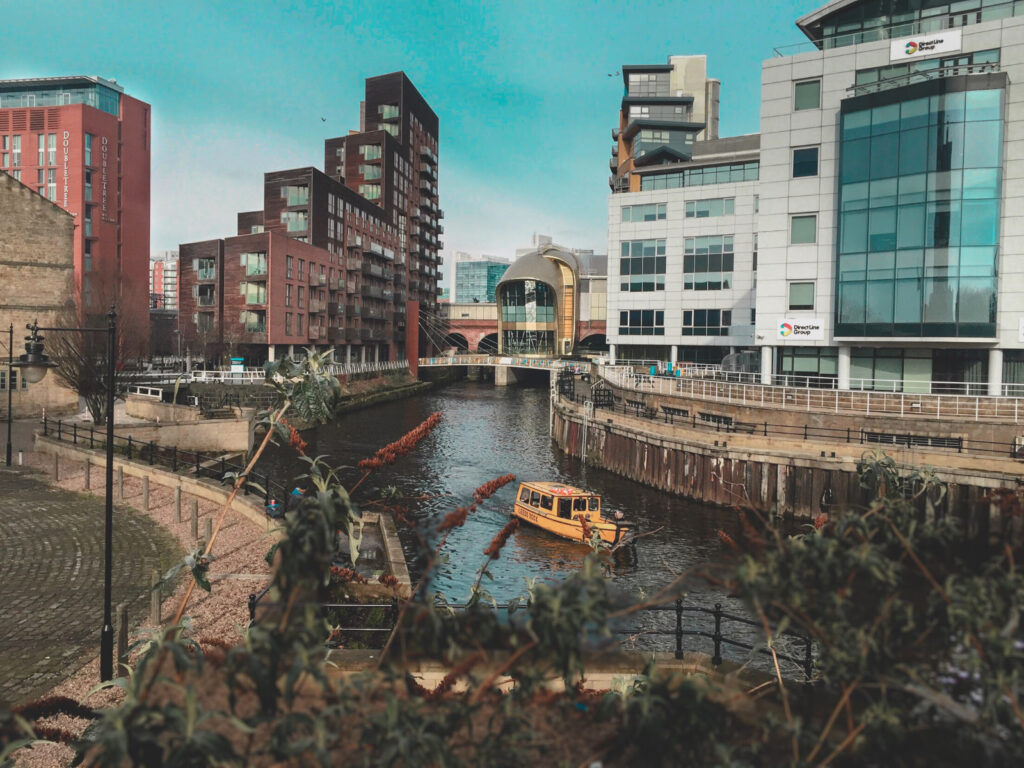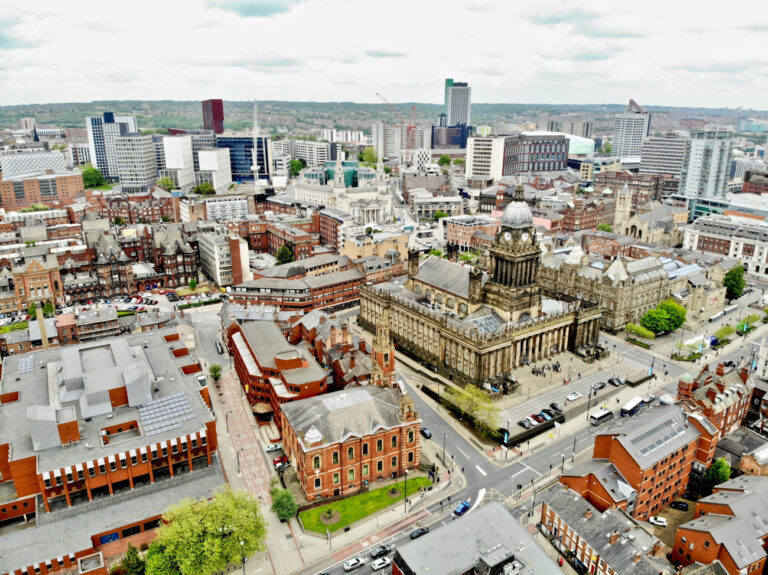The city of Leeds has previously been crowned health and wellbeing champion when it comes to smart-city planning. Stephen Blackburn, data and innovation manager at the local authority, shares their secret
Two years ago, travel guide publisher Lonely Planet ranked Leeds as fifth in its list of the top 10 destinations to visit in Europe. Yes, you read that right: the city, whose popularity is often undermined by efforts to prop up Manchester as the powerhouse of the north, outshone its English neighbours to feature in the annual list that draws inspiration from places with exciting or undiscovered tourist offerings. Amidst the praise was a nod to the city’s urban regeneration efforts, flourishing cultural scene, bustling nightlife, and its growing reputation as the food and drink capital of the north.
That year was a pretty good one for Leeds’s reputation: a few months after the Lonely Planet stamp of approval, Huawei crowned the city the health leader of the year in the company’s annual Smart Cities Index. “Leeds has refreshed its approach to smart city development and continues to be a leader in the development of urban data programmes and a holistic approach to developing a healthy city,” the Chinese company pointed out in the report. “It continues to be a leader in exploring the possibilities of more integrated approaches to health and social care; the role of technologies in supporting people throughout their lives; and the importance of data in improving health outcomes.” All in all, 2017 shaped up to be quite the year for Leeds’s repute on a global scale.

It came as no surprise, then, that one year later NHS England handpicked Yorkshire and the Humber as one of two just regions to become a local health and care record (LHCR) exemplar as part of the programme’s second wave. For the uninitiated, exemplars are NHS England’s response to the need to develop shared health and care records as part of a cross-sector partnership between all responsible parties. This means that, regardless of where a person is treated – whether that’s at the GP, a hospital, or even at home – the professionals looking after them will have full access to coordinated care information. Together with Thames Valley and Surrey, Yorkshire and the Humber followed in the steps of integrated care giants Greater Manchester, London, and Wessex as national frontrunners to mature this initiative.
Many will tell you that a lot of this success stems from the city’s geographical advantage: four out of five NHS national offices are based in Leeds, including NHS England and NHS Digital, as well as the Open Data Institute, key government departments, one of the largest teaching hospitals in the country, a top-tier UK university, and some of the world’s biggest healthcare data platforms (22% of the UK’s digital health sector is employed there.)
“We’re quite lucky in that respect, and we do acknowledge that,” said Stephen Blackburn, who leads on smart cities and open data at Leeds City Council. “It’s about joining up all of those elements together; we work quite collaboratively across the city. We’re in a good location in general as well, right in the centre of the UK. In fact, I suspect that all of that – and the fact that we have a growing digital sector anyway – is perhaps one of the reasons why Channel 4 decided to move here.”
Leeds continues to be a leader in the development of a holistic approach to developing a healthy city
This geographical luck has indeed helped along Leeds’s journey towards better healthcare. For example, the city council has benefitted from NHS Digital’s staff development scheme by embedding health-focused professionals into the local authority in order to learn from their specialised expertise. “We’ve recently welcomed a guy who has worked with our telecare team to change their processes and bring a human-centred design approach to how they deliver services – and, consequently, to provide an improved and more efficient service,” revealed Stephen. “Because NHS Digital has this management scheme to skill up its workforce, it’s looking for what projects its staff can work on – and that’s good for us, because this guy worked with the council. It’s almost like we got some free consultancy, if you’d like, through NHS Digital just because we’re both located where we are.”
But of course, Leeds’s position of privilege in Britain isn’t the be all and end all of its notable success in healthcare. Drawing from an inherent culture of innovation, the city has been building on its large cluster of tech and open-data companies to take a lead on the smart-city revolution in the form of Smart Leeds, the council-led programme designed to identify and deliver new urban solutions. And one of the top three priorities for the organisation is, you guessed it, health and wellbeing.
Let’s go back to the health and care exemplar scheme for a minute. Ambitious in nature, the project draws from a complex web of different organisations: 20 acute trusts, three sustainability and transformation partnerships, five mental health trusts, 22 clinical commissioning groups, almost 800 GP practices, six teaching hospitals, 12 universities, four local enterprise partnerships, and one local clinical research network. Bringing all of these parts together to form a coordinated whole is no small feat, especially considering that some areas already have shared records while others don’t. When Leeds was chosen to become an exemplar in 2018, patient information was still largely kept on paper (which I suppose bodes well for the NHS’s shocking overreliance on fax machines.) To fix this, Leeds and its neighbours within Yorkshire and the Humber have set out to build a ‘system of systems,’ promising to deploy solutions within the next 10+ years through a single federated integration architecture. If the future unfolds as expected, patients will soon be able to access data on the move and contribute to their own record, while staff will benefit from secure messaging systems, urgent care information, and shared care and crisis planning.
“We have patient data saved all over the place. You go to the GP and they make some notes, then you go to the hospital and they make separate notes, and the two don’t see each other’s notes,” lamented Stephen. “The idea with the LHCR was about connecting up those pieces of data. Not necessarily by creating a brand-new system, but by using APIs and joining up the data through the record – that’s the glue in the middle so that clinicians across different trusts and GP practices can see the data.”
At the helm
Complementary to the LHCR initiative is Helm. Appropriately named, Helm is a personal held record that allows individuals to take control of their own wellbeing by consolidating information from a variety of sources under one secure location. “Helm really is about people managing their own data – what we’re calling the ‘left shift,’” the council’s smart-city lead explained. “The LHCR assumes that you’re going into somewhere: a GP practice, an A&E department, etc. But because there are pressures on the NHS in general, we want people to look after their own health better. Helm has a self-care and prevention angle to it: how do we shift people away from presenting at their GP to looking after themselves better in the first place, so that they never need to go there? Helm will eventually be about managing your own health data better, which COULD, should you choose to allow it, feed into the LHCR so that your GP can see how you’re managing your own health.”
The £1.8m data project could allow people to, for example, link up their cycling data on Strava to the Helm interface so that doctors can see how much they have been exercising, and at what intensity. In that sense, it is far from limited to just medical information: the app and desktop portal will spread out into wider public services and seamlessly integrate with personal devices that people already use today.
Helm really is about people managing their own data – what we’re calling the ‘left shift’
The open-data platform, initially launched as a pilot project, has been developed by the Ripple Foundation. The not-for-profit community interest company adopted a leading-edge UX/UI framework and an openEHR-compliant back-end data repository to build a powerful open platform that it believes can help “stop the mediocrity of an underperforming health IT sector.”
Active at any age
Next to Helm sits ACTIVAGE, a Europe-wide initiative based on Internet of Things (IoT) technology that aims to prolong and support the independent living of the older generation. The scheme, which has received funding from the European Union’s Horizon 2020 research and innovation programme, will build the first-ever European IoT ecosystem across nine deployment sites in seven countries and assess the socioeconomic impact of IoT-based smart living environments on quality of life and healthcare sustainability. The ultimate vision is to position itself as the worldwide reference for new business models and cost-effective solutions for active and healthy ageing.

“Our part in that project is to identify and reach out to older people with mild frailty to use Samsung technology in order to monitor their own health,” Stephen told me. “They get given a smartwatch and smartphone, as well as some in-home sensors, that can help identify patterns. For example, if somebody usually switches on their kettle by 10am but has not done so one morning, the system will alert the carer or a loved one. It also monitors their heart rate and other information.
They get given a smartwatch and smartphone, as well as some in-home sensors, that can help identify patterns
“What’s interesting is that Samsung has provided standard pieces of technology that you or I could go to the shop and buy for ourselves. They’re not necessarily bespoke for people with mild frailty. It’s been an interesting project, because Samsung is looking at how existing technology can help people manage their own health better.”
Shortly after our talk, Stephen travelled to Aarhus in Denmark to talk about the project as part of a panel discussion at this year’s IoT Week.
All in
Along the same lines as ACTIVAGE, the city’s new Assisted Living Leeds Innovation (ALL INN) centre has been bringing together a number of assistive technology services under one roof to help service users live better, more independent lives. The first phase of the scheme hosted the Leeds Community Equipment Service (a joint initiative from the city council and the NHS), the Telecare service (for older and vulnerable people), and the council’s Independent Mobility Assessment team (which administers Blue Badges in the city.)
Options for the second phase of the ALL INN centre’s development include schemes around smart houses, an assistive technology retail showroom, and a tech and innovation lab – although a business case for these is still ongoing.
Not another data fiasco
Given Leeds’s trailblazing position when it comes to smart health, there are several other projects we could discuss: the Careview app, for example, is being used by the city council’s public health team to identify links between social isolation or loneliness and things that can be physically observed when walking through a neighbourhood. A massive tablet-lending scheme is bridging the gap between the offline and online worlds by helping the digitally excluded to better navigate tech tools so that they can become more independent in their day-to-day lives. And Leeds Teaching Hospitals NHS Trust has recently submitted a planning application to redevelop the Leeds General Infirmary site by providing a new hospital right in the heart of the city’s Innovation District – described as the place “where science meets healthcare and creative arts.” The new hub’s neighbours will include, amongst others, a £40m university-led innovation and enterprise centre called Nexus.
But regardless of what scheme you focus on, there is a common theme that runs through absolutely all of them: an incomprehensibly large amount of data. So it bears considering: how does the city council, the NHS, and other partners succeed in keeping information airtight, especially when it comes to healthcare – a notoriously complex sector to manage (see also: the Care.data and DeepMind fiascos)?1

For Stephen, it boils down to two things: due diligence and an extremely capable team. Regarding the latter, he said: “We have a very large and very skilled information governance team here, which is very fortunate for us. And certainly, because we are the second largest local authority in the UK, other local authorities often look to us to provide guidance and a steer. Our open data work started in information governance, and it all comes under our wider smart cities programme now.”
And when it comes to due diligence, he emphasised: “We’re very mindful that if we do open up any data, we’ve gone through the appropriate checks to make sure that everything has been anonymised and that there’s no personal data. It’s the same with other work as well – for example, with Helm and similar projects.”
The Care.data debacle saw the contentious programme axed in 2016 after huge issues with confidentiality and information safeguarding – namely, the sale of personal and potentially identifiable data to third parties, such as insurance companies, via a central database. In Stephen’s view, the biggest sticking point in this fiasco stems from the simple notion that most people would be comfortable with sharing their data with the healthcare sector if it was to be used solely for their benefit, such as for research. In Care.data, however, decisions were made behind closed doors, and patients were left angry and confused at how to opt out.
“The main problem with Care.data was how decisions were communicated to members of the public. It was like they said, ‘Right, this is now what we’re doing.’ And people reacted by saying, ‘Hang fire a minute, this is the first time I’ve heard of this!’ But I think the idea is absolutely the right thing to do – looking at how we can better use everyone’s data,” he pointed out. “I’m sure most people would say, ‘Yes, please do use my data in the best way that you can’ – to determine things such as why there is a bigger prevalence of cancer in a specific area, for example. And if we can understand what’s going on, everybody’s health can be improved across the board. That seems perfectly sensible to me.”
Leeds is steering far from this secretive approach in its own projects. The Helm team worked with members of the public and potential users right from the outset, for example, and the ACTIVAGE project is engaging community groups across the district. “You need to design services around your customers. If you’re not including them in the conversation right from the very beginning, it’s more likely that there will be some backlash – that’s the first thing,” Stephen listed. “And secondly, you might end up delivering a service that’s not going to be used, so you’re wasting your time. It’s important that people are consulted right throughout the process when it comes to using their data.”
The main problem with Care.data was how decisions were communicated
These large swathes of data can also be funnelled through machine learning and artificial intelligence (AI) tools in order to extract better meaning from the information collected: for example, the ability to identify if a person’s health has deteriorated. The same will be carried out elsewhere in other sectors: say, using data to determine if a house is becoming increasingly damp so that the council can take preventative action. “We want to be able to identify what’s going wrong before it really does go wrong,” the council officer explained. “We will be relying on AI and machine learning to be able to tell us that in advance, rather than someone sat at their desk ploughing through millions of those data every day. We don’t want to go down that route.”
The city council has carried out extensive data-related work over the last four or so years, especially in relation to open data. For one, it manages Data Mill North, one of the biggest open data sites in the UK. The city also boasts the Leeds Institute for Data Analytics, which works closely with the local authority, and the regional node of the Open Data Institute – where partners host regular ‘innovation labs’ in an effort to fix specific city challenges. Ongoing examples of these labs include sessions looking at how to better exploit technology such as smart speakers in people’s homes to help them manage their health, and assessing what new products (such as Amazon’s Alexa) can be utilised once BT switches off analogue lines by 2025. Innovation lab cycles usually last around six to eight months, a period which covers the initial conversations up to the final deployment of a new solution so that it can be tested with real people, in a real environment. Expect the Alexa-focused workshop to take place around October time.
Having difficult conversations
It’s safe to say Leeds is changing; in a few years’ time, the city hopes to make data siloes a thing of the past. And it’s not just information that will come closer together: the actual partners involved in this linking-up are learning to foster a culture of true collaboration.
Stephen says he’s already been a witness to this cultural shift in action. “I went to a Helm working group a few weeks ago, and there were both council people and NHS people in that room, and we were all talking the same language. We all want to achieve the same outcomes. Just because there are some barriers, whether they be cultural or technical, doesn’t meant to say that you won’t have conversations and you won’t try to get over those barriers,” he told me. “We are an innovative, forward-thinking council that wants to look at how technology and innovation can help us do things better – but that doesn’t mean to say that I don’t have some very tricky conversations with colleagues.
People are fearful of change! But that’s no reason not to do something
“I always joke that without people, things would be a lot easier. At the end of the day, people are fearful of change! But that’s no reason not to do something. What we need to do is work together to deliver these services. And from an IT point of view, it’s not about saying, ‘this is the solution, use it.’ If anything, we kick back against shiny new solutions… because we know that historically, they don’t stay shiny for very long. It’s about identifying what we’re trying to achieve, what outcomes we want, and then working together to get there.”
A shiny new IT solution may indeed turn out to be a part of that, of course – technology is at the heart of any smart city. But it’s not the solution in itself: at the end of the day, it’s just a means to get to where we want to go.

